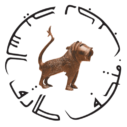Manuscripts & Calligraphy
Manuscripts & Calligraphy
For a short period after the revelation of the Holy Qur’an the Arabs continued to follow the old oral tradition. It was only when a great number of the ‘Huffaz’ (trained people who had committed the Qur’an to memory) were killed in battle, that it was realised that memory alone could never be accurate enough and the Holy book would have to be written down. By AD 651, it had been recorded and codified and official copies were sent to all centres of Muslim learning. It was from these original copies that all future editions were taken. The necessity of recording the Qur’an is precisely what played a central role in the eventual beautifying of the writing so that it would be worthy of divine revelations. Islamic teachings state that the Holy Book was revealed to the Prophet Muhammed in Arabic and so it has the status of divine speech. In the centuries that followed, scribes became highly trained and were respected by even the most powerful Sultans and Emperors, who considered it an honour to learn to write well under the guidance of an eminent scribe.
Although there are various scripts dating from the earliest days of Islam, it is the Kufic script where Arabic starts to fall into a form that is recognisable even today. Although used across the Islamic world, Kufic was particularly popular in North Africa, where the script can still be observed today on shop notices and name plates outside houses. However, with the passage of time, Kufic began to grow very ornamental. Its shapes were plaited, knotted or, more attractively foliated. It could be seen on glass, wood and ceramics. It was woven into textiles and carved into stone. Magnificent examples can still be found in the Mosque of Cordoba and the Alhambra in Granada in Spain. Along with the desire to simply record the Qur’an in the best possible manner, there was also an intense intellectual curiosity and every subject, artistic or scientific, came under the scrutiny of the Muslim scholar. These scholars translated and recorded Greek and Roman learning and contributed their own discoveries. The art of calligraphy developed rapidly across the Islamic world and a people that had never given to writing eventually became calligraphers who produced masterpieces which have not been equalled or surpassed.
The Tareq Rajab Museum houses a very large and important collection of of Al Qur’an and manuscripts from all periods and countries across the Islamic world, including fine examples of writings from renowned calligraphers such as Yaqut Al Musta’simi. Very little of his work has survived; however, his influence was of outstanding importance to the development of Islamic calligraphy. The purpose of the museum’s collection is to illustrate something of the history and development of calligraphy, which grew rapidly from insignificant beginnings into a major art form, the beauty of which has been unsurpassed.
Some of the earliest examples in the museum include a 7th century ‘Ma’il’ (slanting) Script from Hijaz, modern day Saudi Arabia and 9th century Qur’an’s written on vellum from North/East Africa. The museum is also home to one of, if not the only known complete and dated Qur’an written in Kufic script (AD 1002). The museum houses a number of important Holy Qur’an’s, including works by the famous Yaqut al-Musta’simi and his pupil Abdul Allah al-Sairafi. A number of important manuscripts by a number of great philosophers such Qusta ibn Luqa al-Ba’albaki are also on display, as well as an autograph copy of a manuscript on optics by Ya’qub Ibn Ishaq Al-Kindi (AD 902).
Collection Highlights
A few examples of the notable works housed in the museum
Click on each image for more details!
